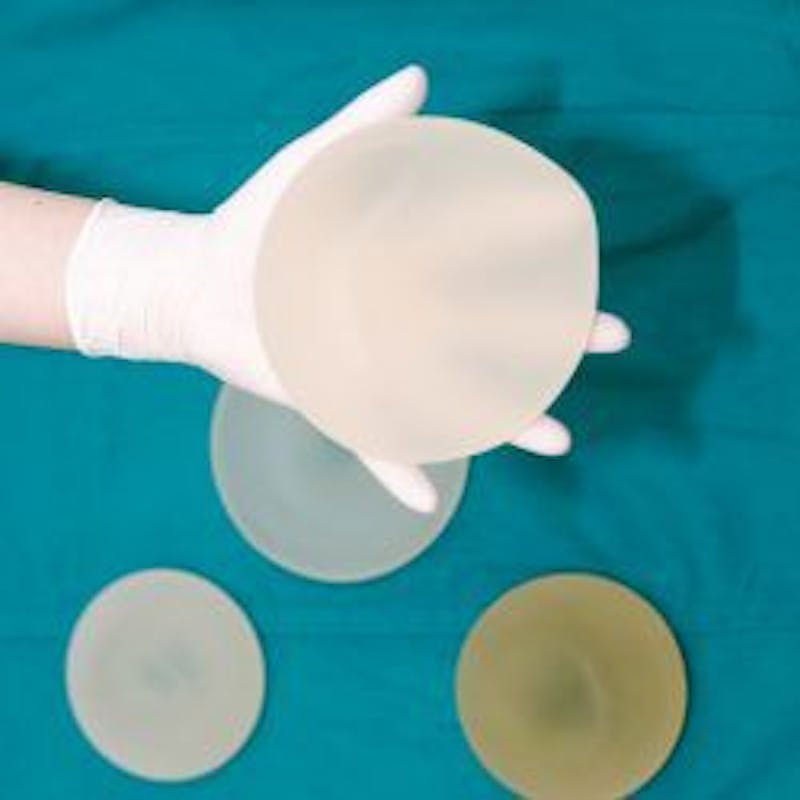
In these days of body acceptance, breast size and shape is still a concern for some women. No matter their age or body type, some women are unhappy with their breasts. Breast augmentation with implants can correct small breasts that lack fat and tissue, breasts that are uneven in size, and can provide fullness after time, after massive weight loss or pregnancy.
It is important to note that choosing really large implants can have its downside in premature sagging or ptosis. Your plastic surgeon will explain the proper size for you based on physical measurements of your body taken in your consultation appointment. Breast implants are measured in cc’s. The higher the number the larger the implant. To translate this to cup size, consider 150 to 200 cc’s to equate to one to one and one half cup sizes. Once the appropriate size is determined you have other breast implant options.
TYPE OF BREAST IMPLANT FILLER
Silicone
Throughout the 1950s and the 1960s, plastic surgeons used synthetic fillers—including silicone injections received by some 50,000 women, from which developed silicone granulomas and breast hardening that required treatment by mastectomy (surgically removing the breast). In 1961, the American plastic surgeons in cooperation with the Dow Corning Corporation developed the first silicone breast implant filled with silicone gel.
Throughout the years, improvements were made with silicone implants to reduce rupturing and capsular contracture, a complication that develops when internal scar tissue forms a tight or constricting capsule around a breast implant, contracting it until it becomes misshapen and hard.
Since the mid-1990s, silicone-gel breast implants are made of a high-strength, highly cohesive silicone gel that mostly eliminates the occurrences of filler leakage and of the migration of the silicone filler from the implant pocket to elsewhere in the body. These implants are considered to form stable implants; commonly referred to as “gummy bear implants”. Gummy bear implants can be sliced in two and each half remained in a stable form, greatly reducing any silicone escaping into the body. A 2005 study showed low incidence-rates of capsular contracture and of device-shell rupture, and greater rates of improved medical-safety and technical-efficacy than that of early generation breast implant devices.
Saline
Saline implants were introduced in 1964 and were the first breast implants available. They were also reliably safe as silicone implants were going through scientific development. Saline breast augmentation is less invasive since the empty breast implants can be placed into the breast pocket and then filled with the saline solution through a tiny port. This means the incisions to insert the implant can be short and small, with smaller and shorter surgical scars than the longer incisions required for inserting pre-filled, silicone-gel implants.
Saline implants are typically less expensive than silicone implants. Something to keep in mind in considering costs. A drawback with saline implants is that they are more apt to show rippling which is a deterrent to some patients. Silicone breast implants have the reputation of feeling more like a natural breast, although this is debatable when saline implants are placed behind the muscle (more about this later).
TYPE OF BREAST IMPLANT SHAPE
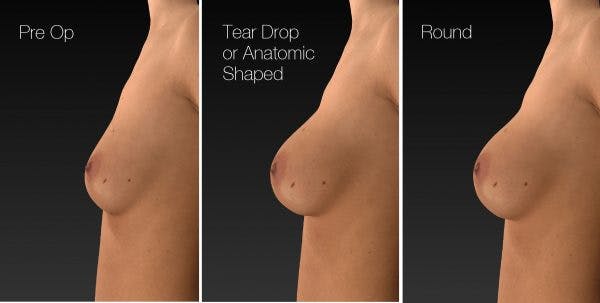
Once you’ve decided on saline or silicone, the type of breast implant shape is another choice you will be asked to make. Upon physical examination and measurements taken by your plastic surgeon, you will be given a choice between a round implant and an anatomic shaped implant. Your surgeon will have suggestions based on what look you would like to achieve. Patients who like the look of obvious augmentation often choose round implants. The larger the implant, the higher they will appear on the chest. Round implants are recommended for patients who need more fullness in the upper portion of the breast and can provide more width as well.
Anatomic shaped implants are tear drop shaped and mimic the natural slope of the breast. These are ideal for women who like their breast shape, have adequate fullness in the top and want to increase the overall size but maintain the shape of their current breasts. Anatomically shaped implants are only available in a cohesive gel.
Both round and anatomic shaped implants are available with a smooth or textured coating. The introduction of a textured surface came from research suggesting that the unevenness of the surface would break the formation of scar tissue and make contractures less likely. The textured surface was also intended to keep the implant from shifting position in the pocket. For the patient, there is no change in the appearance between the two, nor can the different coating be detected. Rely on your surgeon's recommendations when it comes to the choice of textured or smooth.
TYPE OF IMPLANT PLACEMENT
There are two options for the placement of the breast implant. They are in front of the pectoral muscle or behind the pectoral muscle.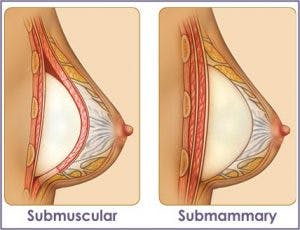
The advantage of placing the breast implant behind the muscle (submuscular) is that the implant edges are often less noticeable. On the downside, the recovery period can be harder because of the pectoral muscle being lifted in order to place the breast implant in the pocket.
The second option is to place the muscle behind the breast tissue but on top of the pectoral muscle. Also called subglandular placement, the advantage of this placement is that the breast is less likely to be misshapen by the overlying muscle. Patients with a significant amount of natural breast tissue (assessed by your plastic surgeon) can choose subglandular placement with relative assurance that the implant edges will not be detected.
TYPE OF BREAST IMPLANT INCISION SITES
An incision must be made in order to insert the breast implants, and there are three typical placement options.
Breast Fold
Placed just beneath the breast where the natural fold meets the chest wall, the breast fold is the easiest incision for your surgeon to make. It allows for direct insertion of the implant and therefore precise placement with minimal tissue disruption. A drawback is that the resulting scar may be visible, but in general, the scar is well hidden underneath the breast.
Periareolar
This type of incision is made in a circular fashion around the nipple. The scar is well hidden in the natural coloration of the areola. For women with small areolas, your surgeon may dissuade you from this if he/she cannot readily insert the implant through the incision site.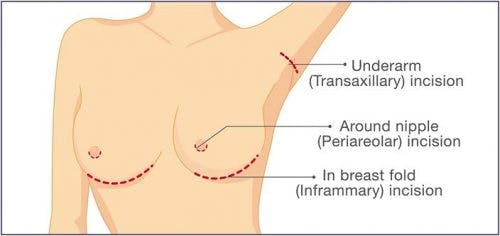
Axillary
Incisions are placed in the armpit and the breast pocket created endoscopically. The appeal of the axillary incision site is that scars are hidden in the armpit. For the surgeon, however, this approach is less than ideal as the distance from armpit to breast pocket is a longer path and ensuring symmetry of the breast implant placement is more difficult.
TYPE OF BREAST IMPLANT PROFILE
Implants come in all shapes and sizes including the dimension of height. The height determines how far the breasts will project outward. Both saline implants and silicone implants come in varying projections. The number of cc.’s remains consistent when choosing the implant profile.
Low Profile
Providing the least amount of projection is the low profile implant. These are good for wide chests and for those who want a very conservative augmentation.
Moderate Profile
This profile is universally flattering and most commonly used. Projecting farther from the chest than the low profile breast implant, it allows more centric project with less bulk on the sides.
High Profile
High profile implants have a smaller circumference base and project the farthest from the body. This type of implant can give good cleavage a little lift to the breasts. Some patients feel high profile implants feel firmer to the touch.
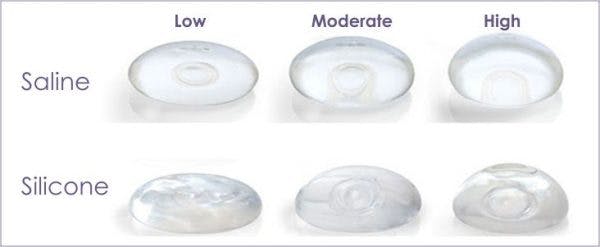
Your breast implant options are part of your overall decision making when choosing breast augmentation with implants. These decisions regarding size, the type of breast implant filler, the implant shape and placement, incisions and profile will amount to a truly personalized and tailor-made breast augmentation.
Changes Plastic Surgery & Spa in San Diego, California offers breast implant augmentation consultations that are complete with 3D computer imaging allowing patients to make these important decisions while viewing each option in a virtual rendering of their own body and breasts. As with most cosmetic surgical procedures, the first step in changing your appearance begins with a face to face conversation with a plastic surgeon. With the input from your plastic surgeon, you will know just the right breast implant options for you, your body and your lifestyle.

